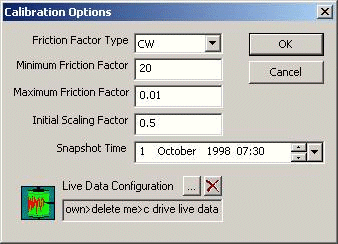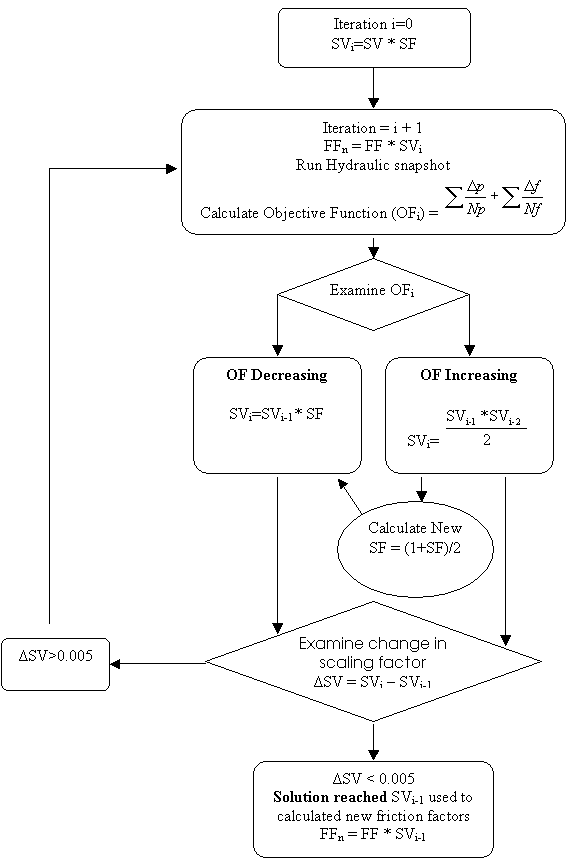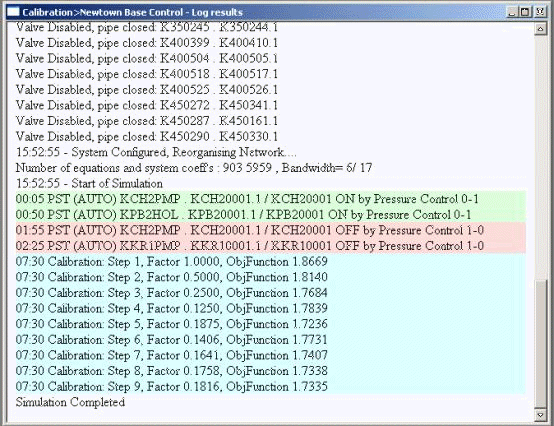|
|
|
Technical Paper March 2005 |
1.1 INTRODUCTION
InfoWorks provides an automatic calibration facility to help speed up work on models where friction factors have a predominant role in calibrating real-life networks. It is not designed for use on networks that have control mechanisms within the network that effect the pressure regime such valves and pumping stations.
Head differentials caused by partially closed valves, inefficient pumps, incorrect PRV, PSV settings are not accounted for in the auto calibration process and could cause an inappropriate pipe weighting of friction factor to be produced/applied.
In these instances it maybe more appropriate to break down the network into smaller zones bounded by the control mechanisms and use a fixed head as a source. This would allow zones in which “known” causes of headloss are only due to friction factor.
A pre requisite for network model calibration is that overall flow balances (demands, leakage, transfers) over the time period (field and model) are in reasonable agreement. If an accurate flow balance has not been achieved auto calibration should not be used.
Subsequent to auto calibration further analysis maybe required to identify areas of significant localised changes in headloss.
Auto calibration can significantly speed-up calibration and analysis work with on large all mains models, where friction factors have a predominant hydraulic role, using field data from loggers, telemetry systems and SCADA, but it is in no means a replacement for an experienced engineer.
1.2 METHOD
The auto-calibration method is based on a repetitive user defined snapshot analysis (normally a peak demand time step) during which friction factors in the simulation are adjusted until a minimum sum of differences between model and observed field data is reached at pressure observation points throughout the network.
The algorithm used is based on common engineering practice and follows simple logical steps in situations where friction coefficients are the predominant factor in network model behaviour, which is typically in large, detailed distribution models
The resultant of the simulation is a factor by which to adjust the friction factors in a checked out network. Once you have carried out a calibration run, you can update the roughness values (if desired) in your checked out network using the factoring.
The software takes the Minimum Friction Factor and Maximum Friction Factor values you entered in the Run Calibration Options dialog and determines equivalent k values for them.

During the calibration process it multiplies the pipe roughness by a scaling factor and determines the equivalent k value for the new pipe roughness. If the new k value is within the limits the software will use it to solve the network at the snapshot time, otherwise the software will use the previous roughness value.
Roughness values will be adjusted if they fall within the calculated headloss coefficient (k) limits. This adjustment will take place for all roughness models used in the network.
NB. If you mix roughness models then you may find roughness values adjusted for pipes that don't use the roughness model you specified in the Run Calibration Options dialog for the calibration limits. In general, it's a good idea to stick to one roughness model in a network.
Variables
- Δ p= Total pressure difference for all pressure calibration points between observed and predicted values at the snapshot.
- Δ f= Total flow difference for all flow calibration points between observed and predicted values at the snapshot.
- Np = Number of pressure calibration points
- Nf = Number of flow calibration points
- FF = Initial friction factors for pipes i = is the value held in the base network at iteration 0.
- FFn = new friction factor for all pipes to be applied to the network for the next snapshot.
- OF = Objective Function - The object function represents how well the results compare to live data and is calculated from sum of pressure and flow differences
- SV = Initially 1 for all simulation – This is recalculated every time an increase in the object function occurs.
- SFini = value entered in calibration options dialogue. The initial scaling factor is just the first guess to where friction factors will move (increase or decrease).
- SVi = Scaling value at iteration i
- ΔSV = change in scaling value, is a convergence parameter which tends to zero as solution reaches minimum objective function (sum of differences). There is internal convergence test if change is less than 0.005 between two successive snapshots. If this is the case the process is terminated and last scaling value is adopted as the solution i.e. Final friction factors = Final Scaling Value x Original Friction Factors
1.3 FLOW DIAGRAM

1.4 RESULTS
Run-time messages during an Auto Calibration run, shows details for each iteration over the same hydraulic snapshot. In this case the Scaling Factor is uniformly increasing and the Objective Function decreasing until the required accuracy is achieved.

1.5 WORKED EXAMPLE
Initial scaling factor = 0.5
|
Step |
Calculation |
Resultant SV |
Resultant SF |
Objective Function |
Objective Function |
|---|---|---|---|---|---|
|
1 |
1.0000 |
|
0.5 (Input in calibration options) |
1.8669 |
- |
|
2 |
1*0.5 |
0.5000 |
|
1.8140 |
Decreasing |
|
3 |
0.5*0.5 |
0.2500 |
|
1.7684 |
Decreasing |
|
4 |
0.25*0.5 |
0.1250 |
0.75 |
1.7839 |
Increasing |
|
5 |
(0.250+0.125)/2 |
0.1875 |
|
1.7236 |
Decreasing |
|
6 |
0.1875*0.75 |
0.1406 |
|
1.7731 |
Increasing |
|
7 |
(0.1875+0.1406)/2 |
0.1641 |
|
1.7407 |
Decreasing |
|
8 |
(0.1875+0.1641)/2 |
0.1758 |
|
1.7338 |
Decreasing |
|
9 |
(0.1875+0.1758)/2 |
0.1816 |
|
1.7335 |
Decreasing |
Step 4 object function increasing therefore solution is between steps 3 and 4 method halves the difference between 3 and 4 i.e. 0.25 and 0.125 and gets 0.1875
The tolerance for the change in scaling factor for when a solution is reached is 0.005 therefore the solution was halted at step 9 when the difference between step 9 and 10 was less than 0.005.
When the objective function changes trend e.g. step 4, then the scaling factor is recalculated, simply for numerical reasons to guarantee convergence and that is how step 6 is calculated. At steps 7,8,9 after the objective function returns to decreasing the increasing formulae is still used and the average scaling value from the last decreasing iteration and i-1 are used.
Article © Wallingford Software 2005

